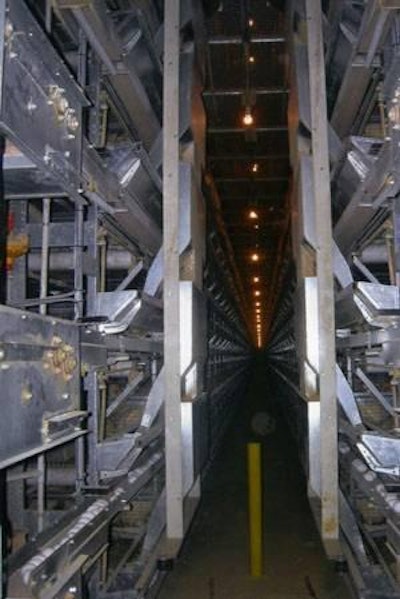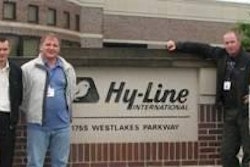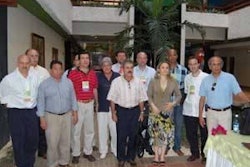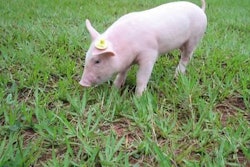
United Egg, the production arm of Dixie Egg Co., recently commissioned a 303,000 hen unit on their Humpty-Dumpty Farm near Hoboken, Ga. According to Jacques Klempf, president of Dixie Egg, the decision was made “to optimize resources including energy and feed and to provide the most cost efficient production system.”
He added “by concentrating hens in a house equipped with multi-tier manure belt batteries we have created an environmentally acceptable and flock-friendly unit, eliminating the use of pesticides, enhancing food safety and the productivity of our flock.”
Nine hens per cage
After reviewing alternative suppliers, United Egg opted for the Tecno Universal multi-tier, on-belt drying system, based on durability, ease of operation and proven success in the European Union. Tecno supplied the steel work and cladding for the house, cages and associated equipment and ventilation.
The system houses nine hens to a cage at a density of 67 square inches per bird with a total of just over 303,000 pullets transferred. Five rows are installed in the 62 foot wide house with a 450 foot cage length. The twelve-tier installation has a catwalk dividing the system into two sub-units of six tiers. Gantrys are installed to facilitate inspections of flocks and the placement and removal of hens. Air is forced over the manure belts to expedite drying. Belts are moved approximately 75 feet each day resulting in complete removal over the 400 foot cage length over five days.
Production variables monitored
There are twelve side-wall extraction fans for minimal ventilation and 42 hp extraction fans mounted in one gable wall for tunnel ventilation. There are two sets of eave inlets with baffles and the ventilation system is programmed to operate in four stages depending on environmental conditions. Each fan is rated at 34,000 cfm providing a total air displacement approaching 6 cfm per hen.
Evaluation of the flock showed uniform temperature with minimal stratification from the lowest tier to the highest and along the cage rows. The Tecno computer management system can program ventilation, adjust inlet openings and operate a high-pressure nozzle evaporative cooling system which may be installed in the future. The computer will also monitor feed and water consumption, egg production for each tier and the entire house and maintain a database of production variables for review by management.
A feed cart system is installed which operates on a two-phase cycle distributing feed on the outward leg and returning after 60 minutes to be refilled. With five feed cycles per day troughs are effectively “refilled” ten times daily.
Clean shells, minimal damage
Manure is conveyed to an adjacent shed where turbine blowers force hot air exhausted from the building down through the manure to reduce moisture content. A detached manure shed with a composter is contemplated for the future when additional houses are erected on the site.
Egg roll-out is efficient due to the slope of the cage floor which follows the EU standard. An arrestor wire holds the eggs beneath the feed trough preventing shell damage. The height of the arrestor wire is adjusted during collection to ensure that eggs are released gently onto belts. The combination of roll-out and staggered release to the belts contributes to clean eggs with minimal shell damage.
Lower cost per hen
Tecno Impiante of Padova (near Venice) supplied the turnkey installation with advanced features at a cost in the vicinity of $14 per hen. Initial estimates of operating costs − including utilities and labor − appear lower than existing high-rise houses on the same farm expressed as a cost per dozen.
Obviously fixed components of cost including depreciation and interest have to be considered in establishing how competitive this installation will be against U.S. sourced equipment and housing. At the very least the advantages of scale are apparent in feed efficiency, labor utilization and management overhead.
For further equipment information access the Techno Impiante Web site.


















